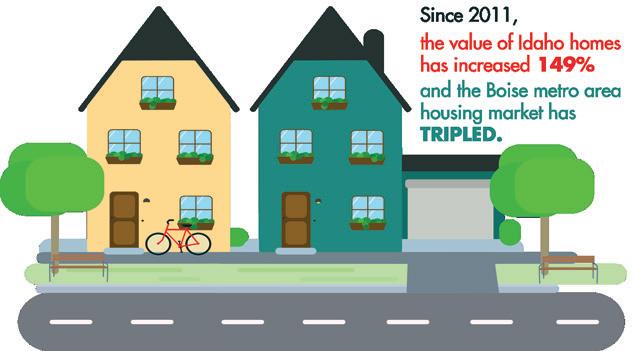
4 minute read
The Hidden Costs of COVID: Homebuilding in a Pandemic
BY HEATHER HAMILTON-POST
“People are willing to pay more for a home, so the price is going up–so willing that they’ll start a bidding war, they’ll pay cash. But as we start the conversation, there’s a number of other items that aren’t so obvious,” says Bill Raur, Executive Officer at Building Contractors Association of Southwestern Idaho. The conversation is happening around Idaho, and especially in the Treasure Valley, where home prices are increasing at unprecedented rates and inventory remains exceedingly low.
Since 2011, Zillow reports that the Boise metro area housing market has tripled in value, marking the largest increase of any of the top 100 largest metro areas. The value of Idaho homes is on the rise too, up 149% since 2011, with a median sales price of $425,000 in Ada County in November of 2020. High demand, diminished supply, and preposterously low interest rates are making the Treasure Valley a focal point for homeownership–and all of this, despite an ongoing global pandemic. So what’s driving demand?
Dan Richter, General Manager at Avimor Partners notes that recent interest rates are actually allowing first time buyers, who may otherwise be priced out, access to a competitive housing market. Zillow adds that millennials are also aging into homeownership and work-from-home protocols are creating a need for more functional living spaces amidst the pandemic.
Avimor is especially uniquely positioned for socially distanced life, given the abundant space and community within. “People live and recreate here.
They’re still getting out and walking around. You’ll see them out conversing with somebody, and standing a little further, but they’re still out,” Richter says. The community, which garnered plenty of interest before, is now in the same position as many–they can’t build homes fast enough.
Richter explains that, at Avimor, they release houses to the market when they’re near completion. It isn’t ideal, but supply chain shortages have created an environment with a lot of unknowns. “It isn’t the way we’re accustomed to doing business, but we’ve adapted,” Richter says. “Costs have gone up so much, probably 50 to 60 percent on developing land alone.”
He says that many production plants and lumber mills slowed or shut down, leading to industry-wide shortages. “Our insulation supplier isn’t even taking new customers. As long as we don’t increase our pace, he can supply it. There are all kinds of appliance shortages too,” Richter says. “So we have to be careful what we promise.”
Raur advocates for a more nuanced conversation about growth–one that acknowledges that builders and developers aren’t growth, but the response to growth. “You have people saying that growth should pay for itself without fully understanding what and who growth is. A home is just like any other manufactured product, and any costs incurred to develop is passed along to the consumer,” he explains.

Among the costs being passed to the consumer are those associated with labor. Richter says that, during and after the Great Recession, the construction industry experienced labor shortages because people retired, and there weren’t young people to take their place. High schools focused more on colleges than trade schools, which created a shortage of labor that he says can delay jobs for weeks at a time. “And COVID-19 has made it worse, because if somebody tests positive on a framing or concrete crew, everybody goes home.”
High demand, diminished supply, and preposterously low interest rates are making the Treasure Valley a focal point for homeownership-all during a pandemic.
And then there’s Impact fees, potential changes in energy code, and global supply shortages and slowdowns. Rauer says he’s heard stories of builders holding lots for fear of overpromising, and that this can sometimes be perceived as waiting for the price to go up. “But that’s not true. This is the formula by which homes are built, and there’s a lot of intricacies involved in that,” he explains.
So what does the future hold for home construction in the Treasure Valley? “I think COVID-19 is going to be with us forever, but I think we’ll be able to go on. Boise is going to continue to be a place people want to be, and I anticipate that by fall, the pandemic won’t be the conversation you have with everybody. I see a lot more younger people getting into the trades, and some of those commodity prices will settle over the next couple of months. But there’s nothing precluding more shutdowns in some of the mills until we get COVID-19 under control. So I think it’s going to be kind of an uphill and downhill; it could be a rough ride this year. Hopefully by next year, there will be some semblance of normalcy.” Richter explains.
Rauer also thinks the demand will continue, and encourages people to think about the big picture of growth, which is far more complicated than builders and developers hoarding resources to improve profit. Avimor will build only 100 new homes this year, but Richter says, if he let the market dictate and he had the labor and supplies, they could sell 500. “I feel bad about the price I have to charge compared to a year ago, but the increase was necessary to stay in business and meet business next year.” Richter says. “Provided the economy holds up, it’ll be tough to find a home in Boise for awhile.”










